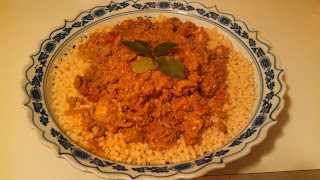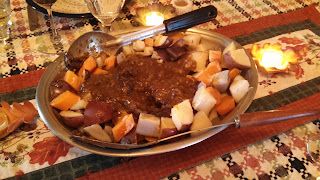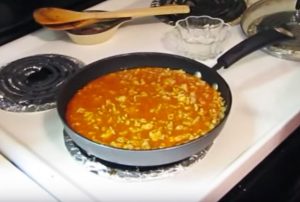I will scarf up anything with eggs in it. I love the suckers: boiled, par-boiled, fried, scrambled, sunny-side up, you name it. One of the favorite is a Greek omelet. Actually, it’s more of a souffled omelet (or omelette). In this case, filled with spinach. So in another universe it could be it could be called “Omelet Florentine.”
This recipe can be a breakfast, lunch, or, dinner entrée. I discovered long ago that eggs are not solely for the morning. Now, let’s talk about the elephant in the room: cholesterol. Recent studies have questioned the whole cholesterol bit. Supposedly, it’s all in the egg yolks. But egg whites really don’t afford the same taste and texture. In this recipe I use both egg whites and yolks. Through trial and error I found that separating the whites from the yolks, beating them separately and then adding them to the omelet makes an airy, fluffy dish. Even if you’re worried about the cholesterol thing, having eggs once in a while is not going to kill you. As with all things. moderation is the key.
This dish goes great with crusty bread, french fries, or (my favorite), served over rice
GREEK OMELET
3 tablespoon olive oil
1 bag (about 8 ounces) spinach, washed and patted dry
Salt and ground black pepper to taste
1 tablespoon fresh oregano or 1 teaspoon dried
2-3 ounces crumbled feta cheese
4 large whole eggs plus 2 egg whites
2 teaspoons grated lemon zest
Chopped fresh dill
1. Preheat oven to 450 degrees F.
2. In a large skillet, heat 1 tablespoon of the oil over medium heat. Add the spinach, salt, pepper, and oregano, and cook, stirring, until the spinach is wilted. Sprinkle with the feta cheese. Set aside and keep warm.
3. In a medium bowl, combine the egg yolks with a pinch of salt, pepper, and the lemon zest. Whisk until the mixture is fluffy, about 3-4 minutes. In a separate bowl, whisk the egg whites until they form soft peaks. Fold the egg whites into the yolks and stir until they are mixed.
4. Heat the remaining olive oil in the skillet, pour in the egg mixture, and gently spread it out evenly. Place the skillet in the middle shelf in the oven and bake until it’s almost cooked, about 3 minutes. If your skillet is not cast-iron or does not have an oven safe handle, cover the handle with foil wrap while baking.
5. Remove omelet from the oven. Spoon the spinach mixture over half of the omelet. Using a spatula, fold the other half of the omelet over to cover the filling. Return the omelet to the oven and bake another 3 minutes. Sprinkle with the dill, cut into serving pieces and serve immediately.
Yield: 4 servings.



 Sofrito is ubiquitous in Caribbean cooking. One could safely say that Puerto Rican cuisine would be wanting without it. It is an aromatic mix of herbs and spices that is a base for cooking countless criollo dishes. This concept can be found in other cultures as well. One example is the Indian mix called garam masala which is also used as a base flavoring. Or kimchi, the fermented cabbage condiment, so popular in Korean cooking. The word sofrito is a generic term that has no correct English translation. “Frito” in Spanish means fried. Sofrito could be taken to mean stir-fried. Although this would not be entirely accurate. As the recipe shows, sofrito can be whipped up in a few moments’ time in a blender or food processor. And it can be stored in a closed tight jar the refrigerator for three to four days or, in the freezer compartment, indefinitely.
Sofrito is ubiquitous in Caribbean cooking. One could safely say that Puerto Rican cuisine would be wanting without it. It is an aromatic mix of herbs and spices that is a base for cooking countless criollo dishes. This concept can be found in other cultures as well. One example is the Indian mix called garam masala which is also used as a base flavoring. Or kimchi, the fermented cabbage condiment, so popular in Korean cooking. The word sofrito is a generic term that has no correct English translation. “Frito” in Spanish means fried. Sofrito could be taken to mean stir-fried. Although this would not be entirely accurate. As the recipe shows, sofrito can be whipped up in a few moments’ time in a blender or food processor. And it can be stored in a closed tight jar the refrigerator for three to four days or, in the freezer compartment, indefinitely. The American Heritage Dictionary of the English Language describes cassava as a tropical American plant with a starchy root from which tapioca is derived. To us Latinos from the Caribbean, it’s yuka (yoo-ka). Yuka is most commonly served peeled and boiled with a bit of olive oil sprinkled on top. But it also yields a bitter or sweet starch known as manioc which is used in the making of farina and, of course, tapioca. For those interested in arcane terminology, manioc is a word of Tupian origin, attributed to the Tupis, a group of American Indian tribes living along the coast of Brazil and the Amazon River valley. To explorers from the Old World, this new food was a wonder.
The American Heritage Dictionary of the English Language describes cassava as a tropical American plant with a starchy root from which tapioca is derived. To us Latinos from the Caribbean, it’s yuka (yoo-ka). Yuka is most commonly served peeled and boiled with a bit of olive oil sprinkled on top. But it also yields a bitter or sweet starch known as manioc which is used in the making of farina and, of course, tapioca. For those interested in arcane terminology, manioc is a word of Tupian origin, attributed to the Tupis, a group of American Indian tribes living along the coast of Brazil and the Amazon River valley. To explorers from the Old World, this new food was a wonder.